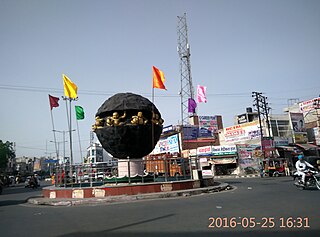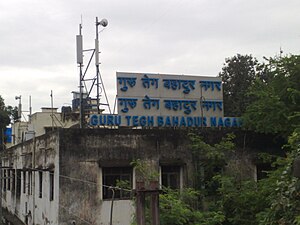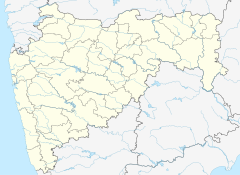
Guru Tegh Bahadur was the ninth of ten gurus who founded the Sikh religion and was the leader of Sikhs from 1665 until his beheading in 1675. He was born in Amritsar, Punjab, India in 1621 and was the youngest son of Guru Hargobind, the sixth Sikh guru. Considered a principled and fearless warrior, he was a learned spiritual scholar and a poet whose 115 hymns are included in the Guru Granth Sahib, which is the main text of Sikhism.

Sewri is a locality along the eastern edge of South Mumbai, in Maharashtra, India. It is also the name of a railway station on the Central Railway Harbour Line.
C.G.S. colony is Asia's largest housing colony to provide housing to employees and staff of any central government body/organisation. C.G.S. is derived from Central Government Employees Society - the "E" is not used usually because saying "CGS" is much easier and faster than saying "CGES", but C.G.E.S. is the official short-form. The colony is located approximately mid-way of the King's Circle and Koliwada or Guru Tegh Bahadur Nagar railway stations. Walking time between C.G.S. and both stations is an average of 20 minutes.

Kaithal is a city and municipal council in the Kaithal district of the Indian state of Haryana. Kaithal was previously a part of Karnal district and later, Kurukshetra district until 1 November 1989, when it became the headquarters of the Kaithal. It shares a border with the Patiala district of state Punjab and the Kurukshetra, Jind and Karnal districts of Haryana. Kaithal district is situated in the North-West of the Haryana state. Its North-West boundaries, which include Guhla-Cheeka are attached to Punjab.
Koliwada refers to a colony of Koli rajputs in India. Several places named Koliwada are located across the Mumbai city in India:
Guru Tegh Bahadur Nagar (GTB Nagar), formerly known as Koliwada, is a neighbourhood in Sion, Mumbai, named after Sri Guru Tegh Bahadur Ji, the ninth Guru of Sikhism.

Dhubri is an old town and headquarter of Dhubri district in Indian state of Assam. It is an old town on the bank of the Brahmaputra river, with historical significance. In 1883, the town was first constituted as a Municipal Board under the British regime. It is situated about 277.4 kilometres (172 mi) west from Dispur, the state capital of Assam.

Gurdwara Sis Ganj Sahib is one of the nine historical Gurdwaras in Delhi. It was first constructed in 1783 as a small shrine by Baghel Singh to commemorate the martyrdom site of the ninth Sikh Guru, Guru Tegh Bahadur and was probably expanded after Indian Rebellion of 1857 or after Partition of India. Before its construction the Mughal Kotwali was situated here. After the Indian Rebellion of 1857 the Mughal Kotwali was demolished by the British and the land was given to the Sikhs as the Maharaja of Patiala and other Sikh soldiers helped the British to defeat the Mughal soldiers by providing large numbers of ammunition and soldiers. Its current building was made by Rai Bahadur Narain Singh a contractor who build most of roads in Lutyens New Delhi construction under British Rule. Situated in Chandni Chowk in Old Delhi, it marks the site where the ninth Sikh Guru was beheaded on the orders of the Mughal emperor Aurangzeb on 11 November 1675. The Sikh regiment of the Indian army salute the Sis Ganj Gurudwara before saluting the president of India since 1979, the only instance of saluting twice in the Republic Day parade by a regiment of Indian army.
Vaisakh is the second month in the Nanakshahi calendar and the Punjabi calendar.

Bhai Mati Das, along with his younger brother Bhai Sati Das were martyrs of early Sikh history. Bhai Mati Das, Bhai Dayala, and Bhai Sati Das were executed at a kotwali (police-station) in the Chandni Chowk area of Delhi, under the express orders of Emperor Aurangzeb just before the martyrdom of Guru Tegh Bahadur. Bhai Mati Das was executed by being bound between two pillars and cut in two.

Bhai Sati Das along with his elder brother Bhai Mati Das were martyrs of early Sikh history. Bhai Sati Das, Bhai Mati Das and Bhai Dyal Das were all executed at kotwali (police-station) in the Chandni Chowk area of Delhi, under the express orders of emperor Aurangzeb just prior to the martyrdom of Guru Tegh Bahadur. Bhai Sati Das was executed by the means of being wrapped in cotton wool soaked in oil and set on fire.

Kandivali formerly Khandolee is a suburb in the north of Mumbai, Maharashtra, India and has a large Gujarati, Marathi, Koli population followed by others. British records highlight a fact which is different from what is suggested in the rest of the article. The area names that ends with "vali" were the actual valleys to the small hills surrounding the area, and that's how we have Kandolee Valley to Kandivali.
Gurdwara Pahila Bara, commonly known as Gurdwara Gai Ghat, is a holy Gurdwara of Sikh religion. It is located in the city of Patna, Bihar, India and dedicated to Guru Nanak Dev. The Gurdwara is part of "Guru Circuit" - A Government of Bihar initiative connecting important Sikh religious destinations in Bihar to attract more pilgrims.

The Guru Tegh Bahadur Nagar metro station is located on the Yellow Line of the Delhi Metro in Guru Teg Bahadur Nagar.
Chak Guru is a village in Shaheed Bhagat Singh Nagar district of Punjab State, India. It is located 9.2 kilometres (5.7 mi) away from Garhshankar, 17.6 kilometres (10.9 mi) from Balachaur, 17 kilometres (11 mi) from district headquarter Shaheed Bhagat Singh Nagar and 87 kilometres (54 mi) from state capital Chandigarh. The village is administrated by Sarpanch an elected representative of the village.
Gaighat is a neighbourhood of Patna in the eastern state of Bihar in India. It is located on the southern bank of river Ganges in Patna. The southern flank of Mahatma Gandhi Setu bridge connecting Patna and Hajipur rises from Gaighat in Patna. One end of Pontoon Bridge (Peepapul) connecting Patna and Hajipur over the river Ganges is also located in the area. Gaighat is part of the wider Alamganj area in Patna.
Mukherjee Nagar, is a neighbourhood in northern Delhi. It was named in honor of Dr. Shyama Prasad Mukherjee
GTB Nagar is a monorail station on Line 1 of the Mumbai Monorail located at Indira Nagar in the Sion suburb of Mumbai, India. Lies on the Truck Terminal Road which is nearby Wadala Truck Terminal.












